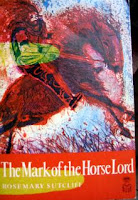 Enter a new cast of characters--the Hyaenodon, the Entelodont, the Megatherium, the Andrewsarchus etc. (there's a character gallery up at Discover). They are fierce, amazing, stunning, and fantastically presented (on the left is a Propalaeotherium, one of the gentle herbivore types). This is the sort of video that the parent has to watch at least once, so as to have at least an idea of what the children are talking about.
Enter a new cast of characters--the Hyaenodon, the Entelodont, the Megatherium, the Andrewsarchus etc. (there's a character gallery up at Discover). They are fierce, amazing, stunning, and fantastically presented (on the left is a Propalaeotherium, one of the gentle herbivore types). This is the sort of video that the parent has to watch at least once, so as to have at least an idea of what the children are talking about.There are 6 discrete episodes, each a bit less than an hour. The narrative follows your basic nature documentary, but the producers tried to have a story line tying each episode together. Episode 3, for instance, follows first year and a bit of an Indocathere calf. Will it survive the drought? the rainy season? its rejection by its mother after she finds a new mate? (warning: adult themes, although tastefully presented). If anyone wants to know the details of all the episodes, look here.

Of all the many non-fiction videos my children have watched, Walking with Prehistoric Beasts has sparked their imaginations the most. Imaginative play, so we are told, is a good thing. No longer does my three-year old want to eat his ice cream at the table, with a spoon. Instead, the bowl goes on the floor, his face goes on the ice cream. "I'm an Andrewsarchus eating a turtle out of its shell!" He snarls around the house, pretending to be a savage Hyaenodon (shown at right), casting his unfortunate big brother in the role of Prey. "Darling, can't you be a gentle herbivore?" I suggest. "ROAR!" he says.
The only episode I did not embrace wholeheartedly was episode 4, which focused on a group of Australophithecus Afaransis (Lucy's species). I appreciate how difficult it is to make a movie when you aren't sure if your characters are "human" or not. I appreciate the fact that they lived in Africa and probably had darker skin than I do. It wasn't bad anthropology. But it made me uncomfortable.
Finally, here's a link to the BBC page, where you can find more information and good games!

















